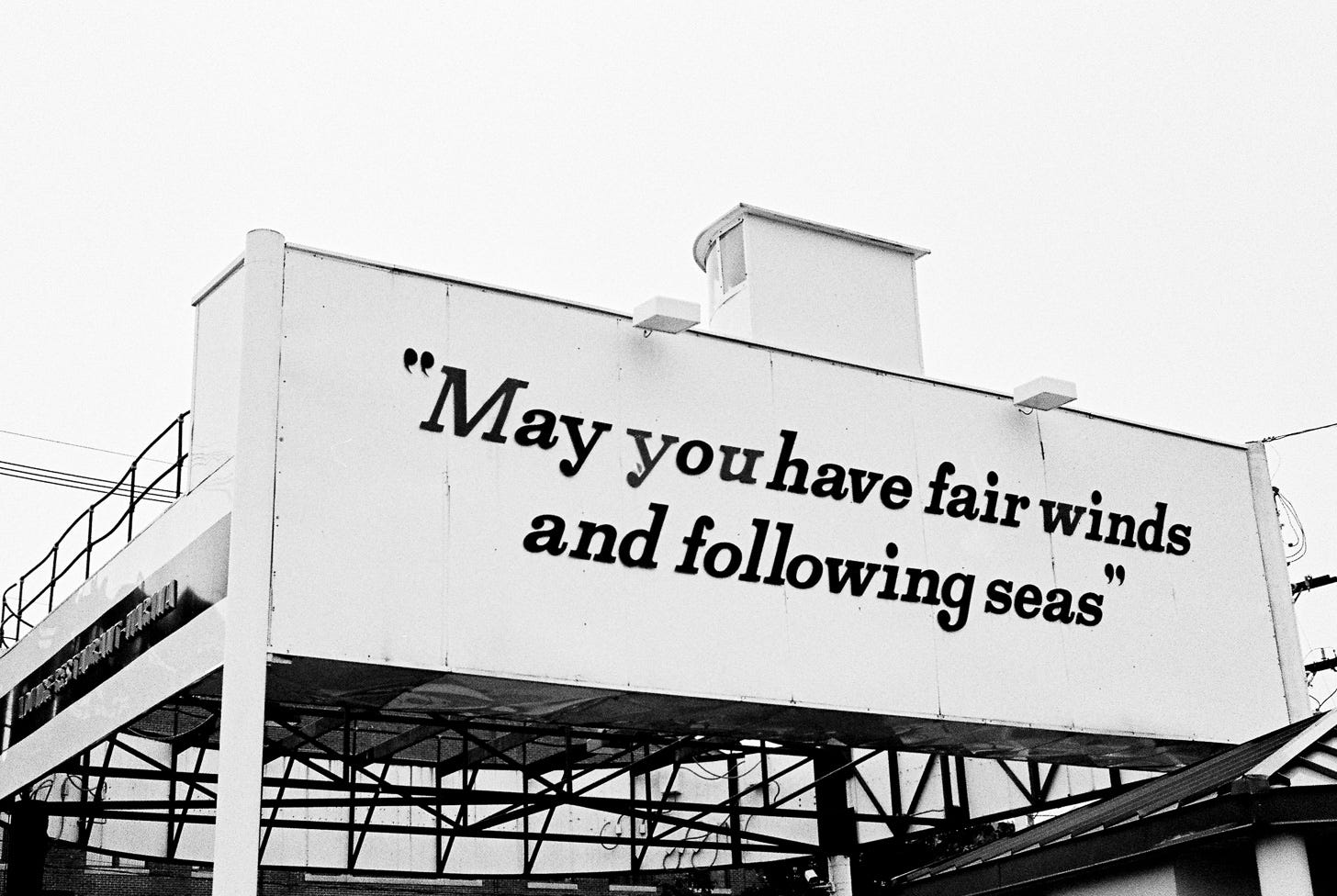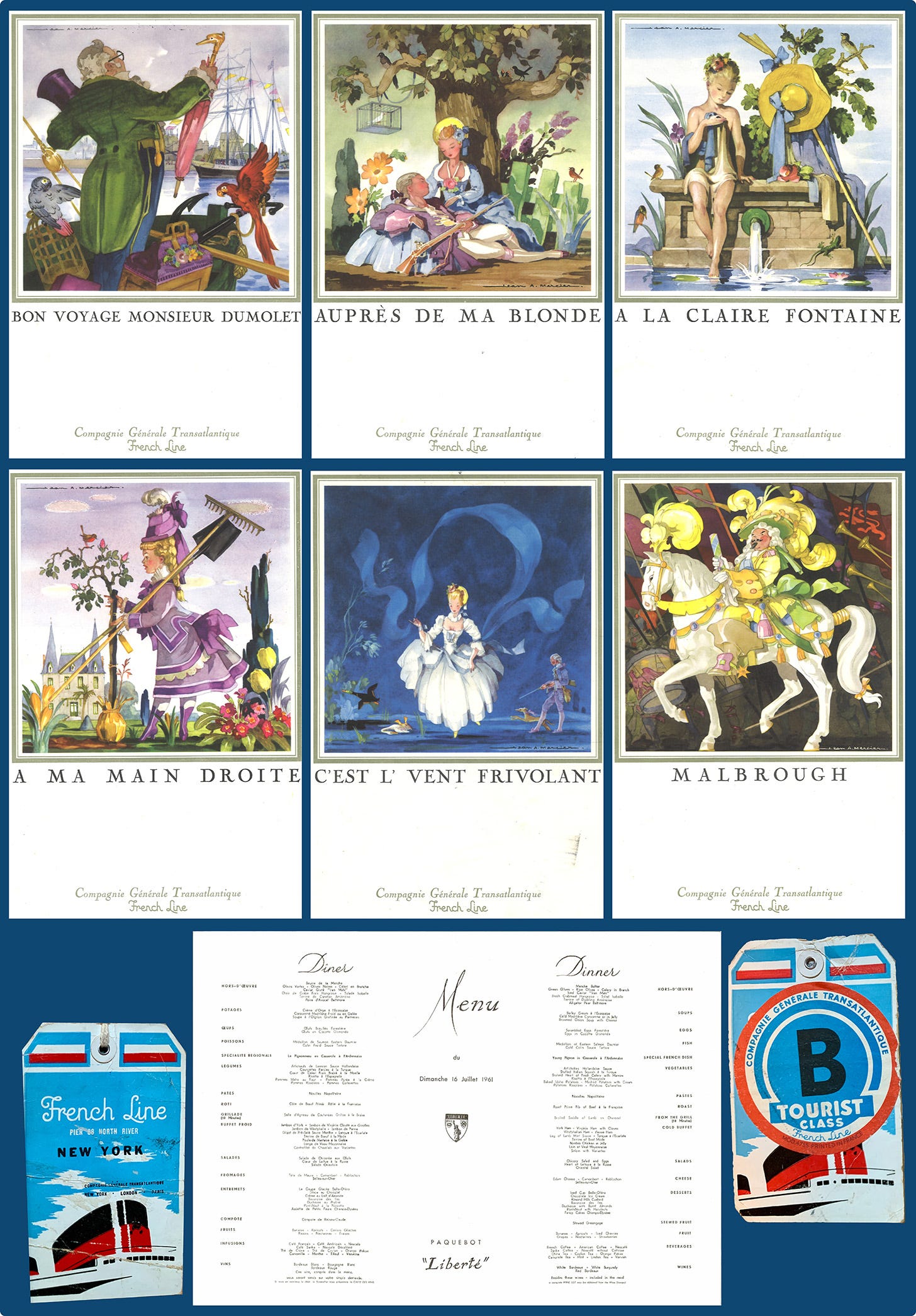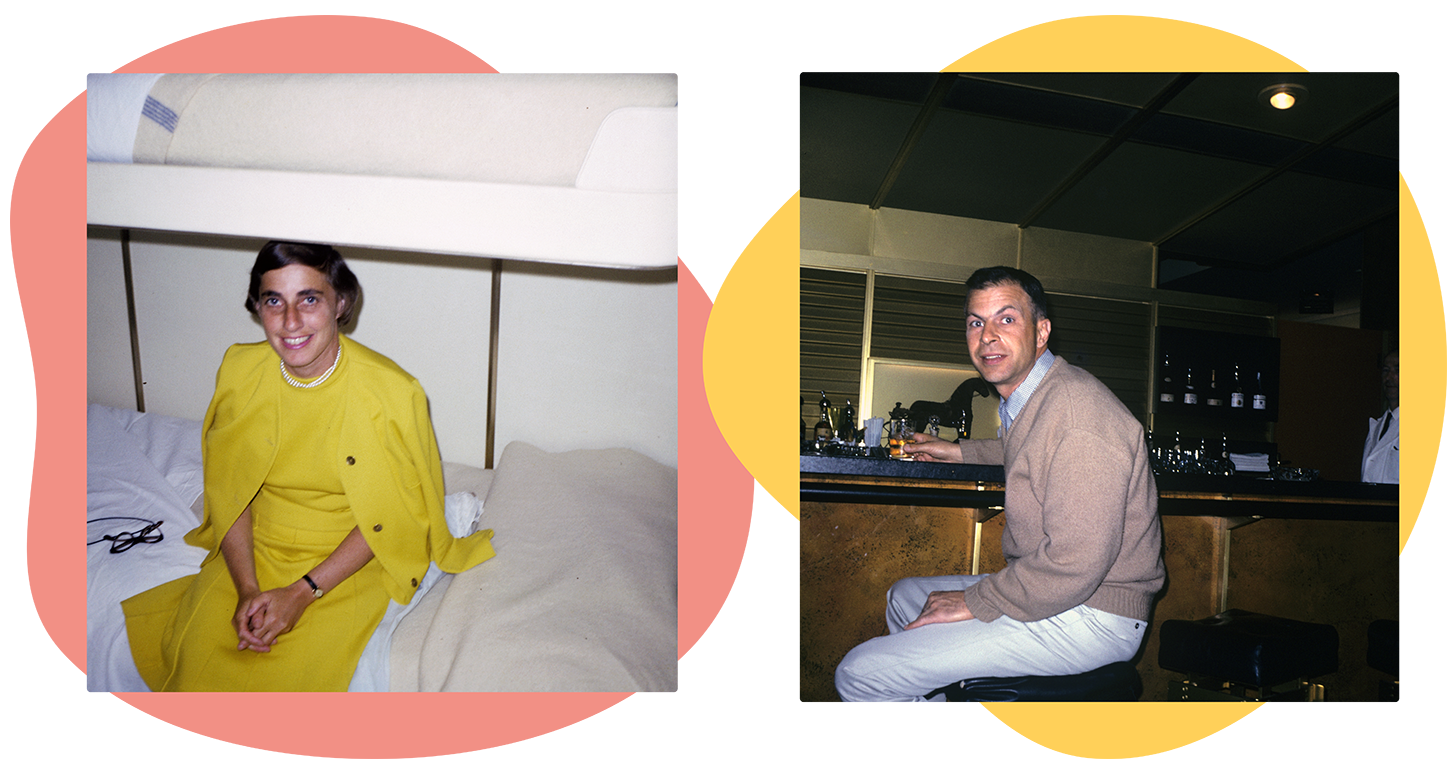The voyage of a lifetime
How my mom's ocean liner menus sparked my own journey into the past
On The Cusp is about becoming the next version of ourselves. That means experimenting with the breadth of our interests, exploring the depths of anything that captures our imagination, and learning to embrace uncertainty along the way.
Welcome! This is letter #51.

As you read these words, I’m headed toward the Sunshine Coast, a stretch of British Columbia’s mainland that can only be accessed by floatplane or ferry because of its unique geography. There aren’t any roads running through the mountainous fjords that separate the rest of the mainland from these little coastal towns.
When I moved to the Pacific Northwest, with its network of inlets, bays, islands, and peninsulas, I acclimated to the idea of taking ferries to many of the beautiful places I wanted to visit. Standing at the bow of a boat headed toward a new-to-me island—Vancouver, San Juan, Orcas, Whidbey, Vashon—made me feel like Dr. Shepherd from Grey’s Anatomy, he of the hospital ferry commute.
As it turns out, though, I have my own family history rich in ship travel.
It took me a full year to sift through the thirty boxes I took from my mom’s house after she died; by the time I unpacked the last one in April, my pace had slowed to a crawl. But I perked up when I saw the treasures waiting inside: a stack of vintage ocean liner menus, each adorned with stunning illustrations.
Suddenly, I remembered my mom’s stories about her 1966 voyage to Europe on the SS France.
I remembered the colorful Europe trip scrapbooks that I’d inherited from her, and the travel mementos I’d found among her things. All this, in turn, helped me recall stories from my dad about his own trans-Atlantic ship travel in 1955 and 1956.
Inspired by my nascent Depth Year, I began to wonder: if I narrowed my focus and dug deeper into these stories and artifacts, what other treasures might I find?
But before I started digging—in fact, at the exact moment I found these gorgeous menus—I thought, “I have to show these to Jolene.”
Jolene Handy is a New Yorker who made Chicago her second home—and that’s where she’s busy investigating the glamorous food history of my hometown.
Each edition of her newsletter transports the reader someplace fabulous, like the Met Galas of years past or the world within one of my favorite (banned) children’s books. Everything she writes includes a drool-worthy recipe, like this tribute to the Dolly Parton song that shares her name; it’s accompanied by a lemony Victoria sponge cake.
I messaged Jolene about my menu discovery, and she responded with three words that led directly down a rabbit hole: “We must talk!”
And talk we did.
The more interest Jolene showed in my discoveries, the more I dug, sifting through my mom’s belongings and interviewing family members who’d sailed abroad. Soon, we were both awash in source material: I couldn’t help myself from sending her scanned copies of the 1966 in-flight TWA menu I found, or the 1969 Greek hotel room service menu.
Jolene, in turn, decided to bake my mom’s favorite banana cake from The Silver Palate Cookbook and write about our exchange—an effort that brought tears to my eyes:
Today, I want to share my discoveries with you, too. So let me introduce you to two people who will regale you with accounts of ocean liner travel in the 1950s and ’60s.
Nancy Disabato, my mom’s sister, is here to speak about the maternal (Brauer) side of my family tree.
Nancy went on two European vacations as a kid, and took an ocean liner on the first trip in 1966. She grew up in Toledo, Ohio with her parents Cal and Margot and siblings Debbie and Bobby, who you’ll see pictured below. All photos are thanks to Nancy’s scanning efforts!
Tom Burton, my dad, is here to speak about the paternal (Burton) side of my family tree.
Tom spent a year abroad starting in 1955, and took ocean liners there and back. He grew up in Mishawaka, Indiana with his parents Milton and Sarah and brother Jamie.
Our interviews have been edited and condensed for flow and clarity.
Maddie: Nancy, I found a letter you wrote in 1967. It starts: “Dear Jan, Mom's been saving and planning to go to Europe since Debbie was born. Well, we went there last summer.”
Nancy: My mom and her sister and brother had gone to Europe, and she was very determined to do the same trip with us. I think we could have easily flown to Europe, because we flew home, but that wasn't the experience my mom wanted for us. She had gone over on a ship, and she wanted us to go over on a ship, and that was the end of the conversation.
She worked part-time, a day and a half a week as an occupational therapist, and she saved all that money. My mom bought stock—Xerox and Kodak—with her income. My father thought Xerox was never going to make it. He thought it was crazy. But the stock went up.
So after a number of years of saving, she cashed in her stock. I don't know if she cashed all of it in because we went to Europe again three years later. It cost about $5,000 for five weeks; I think she paid for all of it.
My dad had been in the Navy and he was not interested in going to Europe on a ship. He was on the USS Columbia in the South Pacific theater [of World War II]. He had been on a ship for almost four years and was like, “Why would I ever get on a ship again?”
So it took a lot of convincing, I think, on my mom's part. He’d had enough ships in his life, but Mom talked him into it.
Maddie: Dad, I know that you had a pretty scary near-miss with your family’s travel plans.
In 1956, the MS Stockholm collided with the SS Andrea Doria—and your family was originally scheduled to be on the MS Stockholm.
Tom: Yeah, my parents had made a reservation for us to return to America on the Stockholm.
For some reason—some sort of conflict with somebody's plans—they changed the reservation, and we went back on another ship in the Holland America line. So we were pretty lucky not to have been involved in that particular voyage of the Stockholm.
Maddie: Nancy, how did you get from Toledo to port in New York City?
Nancy: A friend of ours dropped us off at the train station in Toledo, and we took the train. We had these little blue suitcases. My mother was so organized. She told us, “All of you have to be able to carry your own suitcases.”
We went to the top of the Empire State Building and could see the ship from there. I remember that specifically because I was afraid to go on elevators; I had gotten stuck many years ago in an elevator at a piano recital with Debbie.
The next day, we got on the ship and sailed.
Maddie: Dad, what do you remember about seeing the ship for the first time, and about setting sail?
Tom: I remember being awestruck by the size of the ship. It was the Nieuw Amsterdam, of the Holland America Line. I remember casting off from New York Harbor and looking over the buildings of New York City—being from Indiana, I had never seen anything like that before. So we're going past the tallest buildings in the world at the time.
I had seen the ocean when we visited my aunt in North Carolina, but never from a boat like this. I remember looking down and being amazed at how blue the water looked—sapphire blue.
And I remember little things like the porthole: I'd never seen a round window before! I thought that was pretty funny.
Maddie: Nancy, how long did your journey take?
Nancy: I'm pretty sure it was five days.
Maddie: And what were your first impressions of the ship?
Nancy: We were in second class—not in first class—and we had a maid and a butler assigned to us. Again, this was second class. So that stuck out to me. You have to wonder what first class was like, because second was pretty nice.
I slept in a bunk bed. Our room wasn't very big. Debbie and I shared a bunk and we got in a fight because I wanted the upper bunk and she got it. There was a picture where I had been crying. My father said “Get up on the bunk and smile,” and my eyes are all red. That's probably why I remember that.
Part of the reason you remember these trips is because we watched the slides every effing year. You know, we're like, “Oh God, not the Europe slides again.” My dad would put the slides up and we'd have to look at all of them all over again.
Bobby and I used to run around the ship, and we would get lost. It was very big. We would run all over the place—I'm sure we were a nightmare.
We would always take the wrong elevator, and when we tried to get off, we got in trouble because we were in the first class section, which we were not allowed to go in. Like, you were sent back down on the elevator.
I remember being on the deck and my parents would just be sitting there, covered in blankets. My father was taken care of. I mean, he had worked on a warship, and so this was such a luxury for him. So of course he loved it.
I don’t remember any waves. Just beautiful clear sailing from New York to Southampton.
Maddie: Dad, you were only five years old, but do you remember anything about the amenities onboard?
Tom: I remember there was a pool on the ship. Not on the main deck, but below, in the center of the ship. After awhile, the voyage got rough enough that the waves [in the pool] were literally slapping up against the ceiling of the pool room.
Maddie: Nancy, what did you do when you weren’t running around?
Nancy: There was a movie theater on the ship. They had movies playing all day long.
You could go in anytime, and that was the most amazing thing in the whole world, to be able to go into a theater and just watch a movie whenever you want to. This was light years before streaming. I loved movies, so I was just amazed.
Maddie: Nancy, what do you remember about the food onboard?
Nancy: They may have brought breakfast to us, which was fresh fruit and croissants every morning—and I'm sure coffee and juice and water. It was the SS France, so I think it was all French food.
But what I truly remember was nighttime; we had to dress up for dinner. Again, this is second class. We had tables with tablecloths. You’ve seen the menus. It wasn’t a buffet; we were served dinner every night. You didn't order, but they brought you food. We had to behave. My father was always strict, so we were good at behaving.
There was this beautiful French woman with her little boy François who was in a high chair next to us, and he screamed every night. I think my parents tolerated it because he was so cute, and the woman was so beautiful. I’m sure my dad was entranced.
I don't really remember the meals—I was a much pickier eater than Debbie, and got into some trouble for that in Paris. I think the most memorable thing was the wine at dinner every night. That was a little unusual. My dad really got into wine after that trip.
Maddie: Dad, tell me your clearest food memories.
Tom: They served consommé at every meal, and also up on deck. I'd never seen consommé before that. This was really an eye-opening thing for a five-year old. Though I thought consommé was not so great—I couldn't understand what the big fuss was about.
I remember being out on deck and being awestruck by the ocean, and watching everything go by. And I remember all the other people sitting around drinking consommé. And once I tasted it, I just didn't understand why all these people wanted consommé. I guess the real answer is that a lot of them were seasick.
On the other hand: crêpes Suzette! I was really impressed with crêpes Suzette, because while I had seen pancakes before, I'd never seen really teeny, thin pancakes with blueberry sauce. They put brandy on the pancakes and set them on fire. And I thought that was pretty awesome.
I was so impressed by the fanciness of the way all the waiters were dressed, and the presentation of the food, that every meal made a big impression on me. Mealtime was so novel and exciting for me as a little kid; I really wanted to see what the next one was like.
It was all very formal, sort of like a Cary Grant movie. I didn't know anything about Cary Grant at the time, but if you’ve seen An Affair to Remember, that image of [him and Deborah Kerr] on the ship—that's the way I remember it.
Stay tuned for a very special Part 2 about Tom and Nancy’s experiences abroad.
This feels like the perfect time to mention my mom’s favorite poem: “Sea-Fever,” by John Masefield. // I loved this essay from Brent and Michael Are Going Places, about the things we lost when travel planning became easy. // My dad’s favorite seafaring song, by Stan Rogers, is stuck in my head. // I was captivated by the story of this long-lost piano from the Titanic’s sister ship.
As always, I’d love to hear from you. When’s the last time you dug deeper into your family history? What did you find there?
Warmly,
Maddie






















Those menus are beautiful! Love this collab between you and Jolene
Maddie, this is incredible —what you’ve done here is absolutely beautiful. The conversations are so vivid and sweet and your questions let the memories flow about the trip, about your mom, every small detail . What an honor it’s been for me to watch your process of telling this story unfold. I can’t wait for part two. This is touching and breathtaking. ❤️